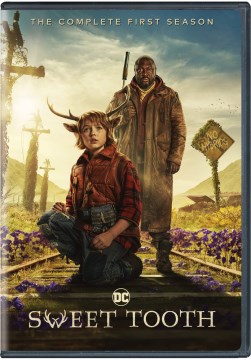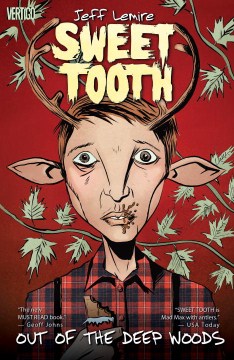While I have a lot of frustrations concerning streaming services, one net positive gain from competing channels (Netflix vs. Max vs. Paramount+, etc.) is the wealth of creative story-telling attempts. Each platform seems to have dipped its toes into the proverbial water of show creation, and many of those platform-created shows rank among each platform’s most popular or most-streamed offerings. However, many of these original ideas are not so much original as they are unique adaptations or twists to the existing source material. Today I would like to discuss a popular Netflix creation called Sweet Tooth.
Sweet Tooth
Genres: Action; Adventure; Drama
First Released: 2021
Multiple Seasons?: Yes; 2 available through Netflix, with a third and final season confirmed TBR
Call Number: DVD TV SWEET SEASON 1 | 2 DISCS
Eyan’s Rating: 4.0/5 Stars
You’ll Enjoy This If: Post-apocalyptical stories are your favorite; The Last of Us was just a little too depressing for you
Show Summary
Ten years ago, “The Great Crumble” wreaked havoc on the world and led to the mysterious emergence of hybrid babies born part human, part animal. Unsure if hybrids are the cause or result of the virus, many humans fear and hunt them. After a decade of living safely in his secluded forest home, a sheltered hybrid deer-boy named Gus (Christian Convery) unexpectedly befriends a wandering loner named Jepperd (Nonso Anozie). Together they set out on an extraordinary adventure across what’s left of America in search of answers about Gus’ origins, Jepperd’s past and the true meaning of home. But their story is full of unexpected allies and enemies, and Gus quickly learns the lush, dangerous world outside the forest is more complex than he ever could have imagined.
Eyan’s Review
With only 8 episodes per season, catching up on Sweet Tooth was a single weekend’s adventure. I was immediately taken in by Gus, played by Christian Convery on the show. It’s difficult to cast child actors, I feel, and as a viewer, I am often annoyed by the depictions of children and young adults in films as they are often stereotyped down to one or two traits (teens are angsty, for example) or it’s just difficult to act at that age, I’m sure. However, I think Christian Convery did a fantastic job as the primary lead of the show through both seasons. While the narrative also focuses on “Big Man” Jeppard, the story is ultimately about Gus.
One of the things the show does well is bouncing between storylines and timelines in a way that enhances the revelations rather than confusing viewers. While told mostly in a linear fashion, like the majority of characters involved in the show, the actual events leading up to the Great Crumble and the virus, only known as “the Sick,” are vague and mysterious. It doesn’t matter why the world crumbled as much as it matters to survive, to keep going, for these characters.
But Gus, who has been raised in seclusion by a man he calls “Pubba” (played with great emotion by the incredible Will Forte), has this incredible naivete to him. He’s empathic and kind, and while he knows nothing about the world beyond their fence to start, he doesn’t lose that empathy regardless of hardship and difficulty.
There are a lot of themes I wish the show would have explored more, and with only one more season before the narrative concludes, I don’t think those themes will play out the way I want them to. One of the biggest questions in the world of Sweet Tooth is what caused the Sick, and because hybrids seemingly came into existence at the same time, the assumption is there is some kind of negative connection between the two. Hybrid children are hunted and experimented on, when not killed outright. Without spoiling any of the reveals, I think this is one area that the show falls short of portraying the intensity of the unknown. While most hybrids are abandoned and therefore become feral, it seems as though the bulk of the surviving population assumes that hybrids are, therefore, incapable of humanity. They are solely animals and, like lab rats, not burdened with the ethical concerns of torture and experimentation, especially if it means a cure for the Sick could be produced. Because Gus is our protagonist, however, as an audience, we understand immediately that hybrid children are children and retain their humanity. Those hybrids seen as feral are, in fact, feral children, a very real consequence of abandonment that happens in our world to fully human children, too.
The impact of this dichotomy, in the show, is that we don’t perceive the other characters as morally grey or questionable. We just see them as evil. It isn’t until near the end of season 1 that viewers really get insight into the way that society views hybrids in this post-apocalyptic world, so for hours of watching Dr. Singh’s struggle as he learns increasingly more about the research involved in finding a cure, I didn’t really feel like I could sympathize with him. His character is driven entirely by love for his wife, who has been created entirely for the show. I think this additional character creation is an attempt to justify Dr. Singh’s motivations as he becomes increasingly willing to do morally terrible things, but I think it would have been a stronger story-telling tact to reinforce just how differently people of this world view hybrids than the audience does. I don’t care about his relationship with his wife, because once he learns how the medicine they use to keep her alive is made, I cannot continue to suspend my disbelief.
This kind of moral choice question is becoming increasingly popular in apocalyptic fiction. The same question is raised at the end of The Last of Us: What would you do for the person you love? How far would you go to survive?
Sweet Tooth
Genres: Action; Adventure; Drama
First Released: 2009
Multiple Volumes?: Yes; 6 total volumes
Eyan’s Rating: 3.5/5 Stars
You’ll Enjoy This If: You read and enjoyed The Walking Dead
Comic Summary
Seven years ago, the Affliction raged like a forest fire, killing billions. The only children born since are part of a new breed of human-animal hybrids. Gus is one of these children: a boy with a sweet soul, a sweeter tooth–and the features of a deer. But kids like Gus have a price on their heads. When vicious hunters descend on his isolated forest home, a mysterious and violent man called Jepperd rescues Gus. The hulking drifter promises to lead Gus to the Preserve, a fabled safe haven for hybrid children. As they cross the dangerous new American frontier, will Jepperd corrupt the boy he’s nicknamed “Sweet Tooth,” or will Gus’ heart change Jepperd?
Eyan’s Review
Right away, you can see some changes have been made. First, the timeline of the apocalypse in the original source material is shortened to seven years, whereas the show has expanded the timeline to ten. It’s a small change, but one that ages Gus into a more believable age for the way he speaks, acts and understands the world around him. I didn’t enjoy the comics as much as I enjoyed the show, despite some other changes, because I think the show picked up on the underlying theme of the comic, more than it lifted the plot directly. Adaptation is a tricky art, even when moving from one visual medium, comics, to another, television. There are six collected volumes of Sweet Tooth, telling the complete run of a very specific story centered around Gus.
The comics are much more fantasy than the show, which I feel has been enhancing and increasing the scientific aspects of this world much more than the comics. In the comics, the ultimate reason behind the Sick and behind Hybrids is…very fantastical. It’s not that I don’t “believe” it, because in fiction, anything can happen, but it doesn’t have the same impact I think the show is going for. Of course, with the final season of the show heading to Alaska, where the comics start and end, there’s still time to swing back around from scientific experiments gone awry to “humans explored too much and now there are consequences.”
The first two seasons of the show have also exhausted at least half, if not slightly more, of the comics’ source material. Part of that is the lack of depth in the comics. I don’t mean the story is told poorly, I just think there’s only one or two stories being told, and there aren’t as many layers going on. While I think the character of Dr. Singh makes more sense in the comics in terms of motivation and execution, he is the only character I like more on the page than on the screen. there’s nothing wrong with comic-book Jeppard, but he’s very bland and unlikeable. He has a tragic past he’s trying to atone for, but Nonso Anozie just brings so much feeling to Jeppard that I cared deeply about what happened to him on the screen, whereas I really didn’t care for him at all in the comics. Again, I’m not sure the intent of the comic is for anyone to like any of the fully human characters, and there’s a reason for that. But when I say I liked or didn’t like a character, sometimes I mean to say the development of that character was engaging and interesting, and I cared what choices he made.
It’s fascinating to note that the comics were both written by and inked by Jeff Lemire and published by Vertigo, an imprint of DC. Yes, the same DC behind Batman and Superman has a smaller imprint company that publishes DC and author-owned holdings that fit a more specific theme or category. Begun as an imprint to publish more adult storylines, Vertigo shifted to emphasize more horror-driven content in the ’90s but ultimately was discontinued in 2020. For a comic to be both written and inked by the same person is increasingly uncommon, as well, showing the level of engagement in the story Lemire held. His current work includes massive titles in both the DC and Marvel universes, where he often works with a team of writers and artists to produce new comic books in a particular character’s story run.
Overall, I’d recommend the run, which is complete and not super long, to anyone interested in post-apocalyptic stories, stories about humanity and monstrosity or stories about survival under any circumstances. Fountaindale doesn’t hold physical copies, though you can request them through the online catalog and will receive them here in a couple of days, as our consortium holds copies at other libraries, but you can also access them immediately with the Hoopla app. I read the comics mostly through Hoopla, which has a fantastic interface for graphic novels. I definitely recommend the show, as well. You can check out season 1 on DVD right now, but if you don’t want to wait for season 2, check out a Roku on the third floor to access through the Library’s Netflix subscription.


